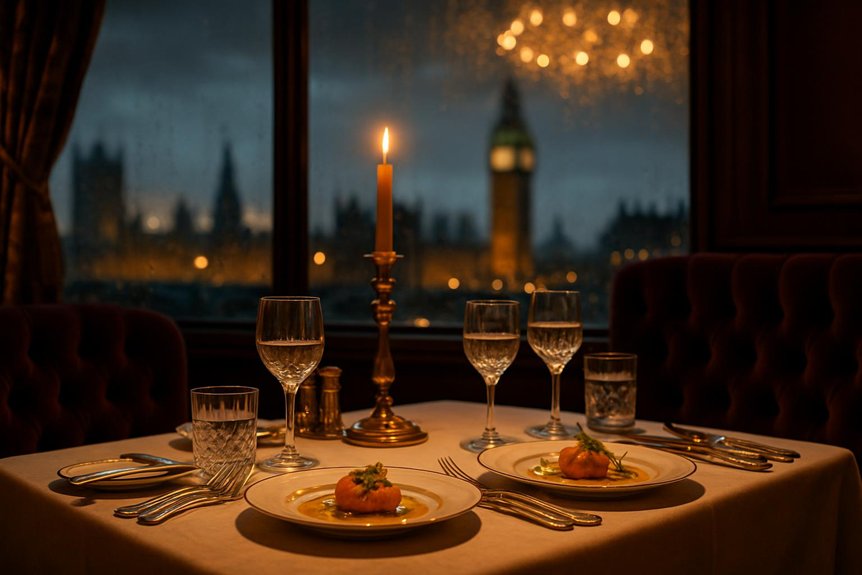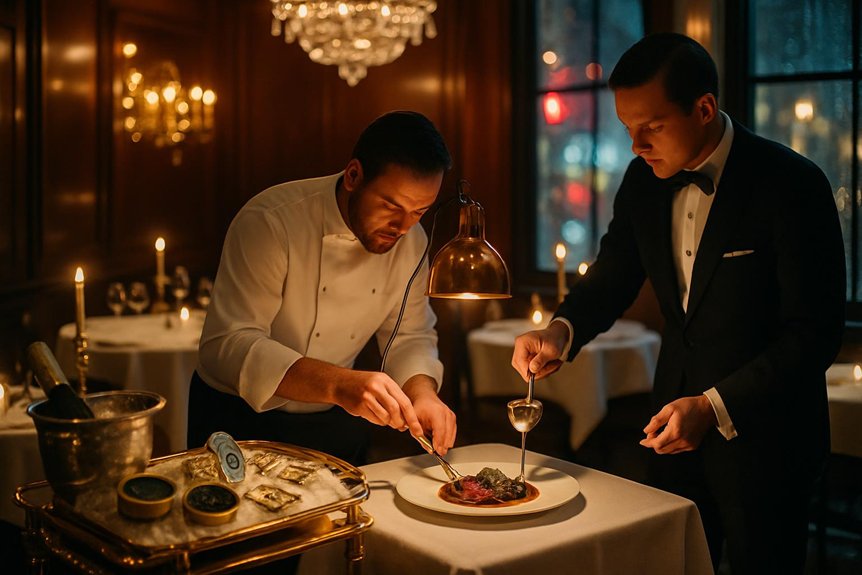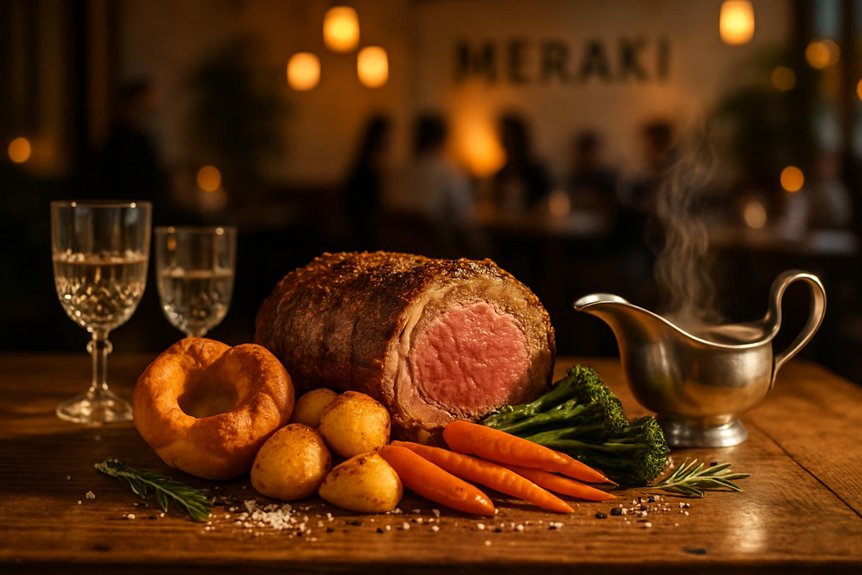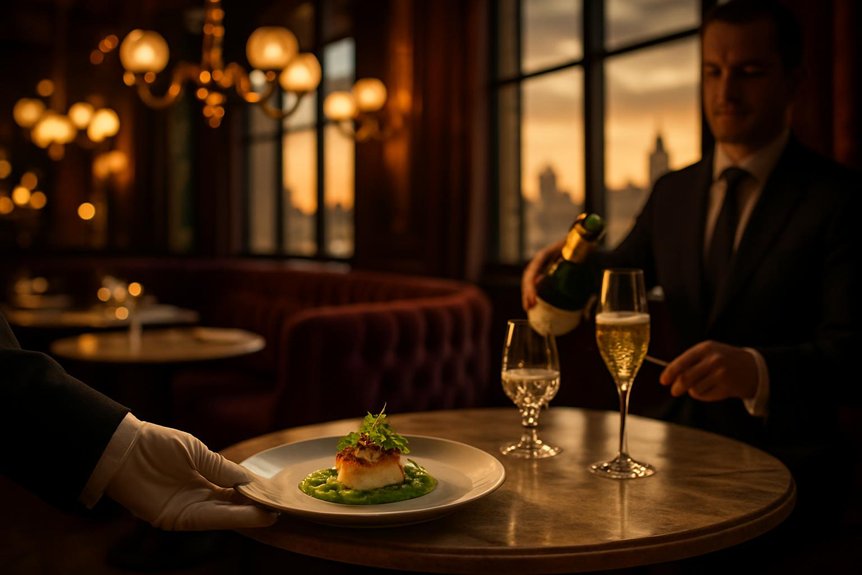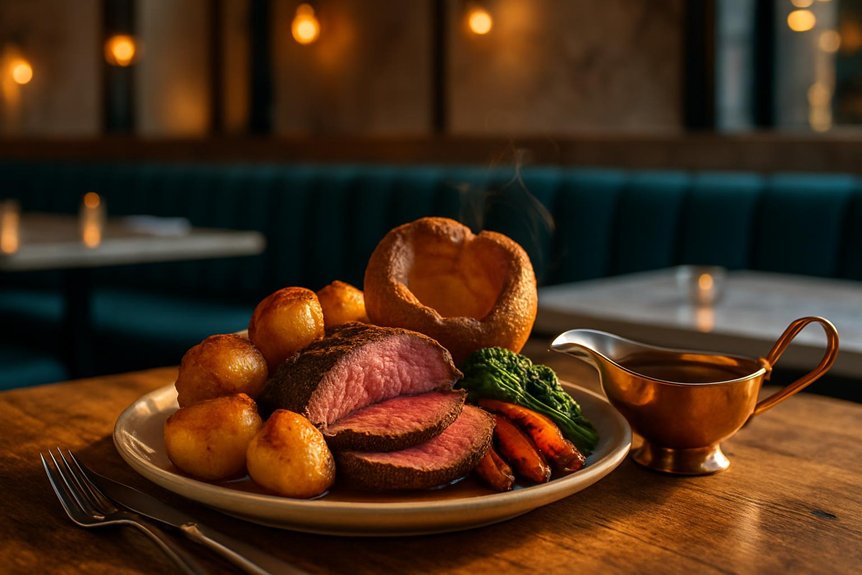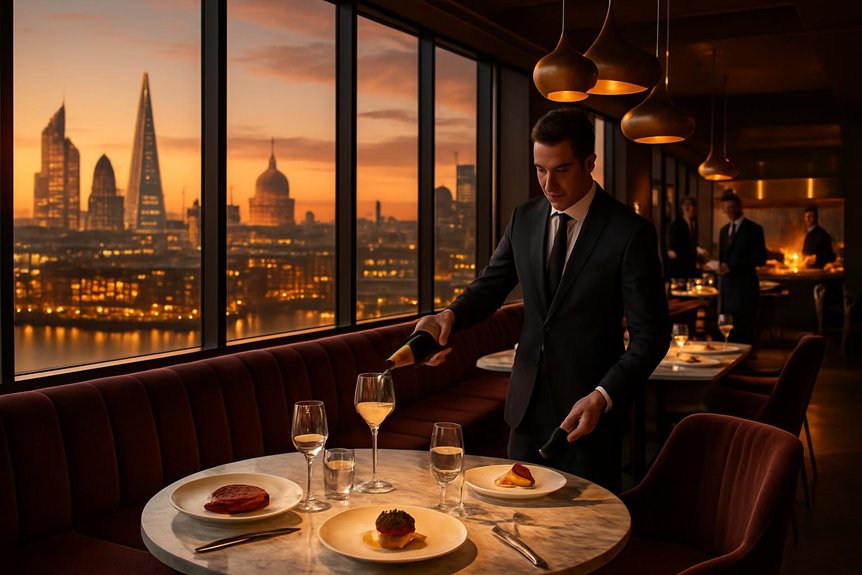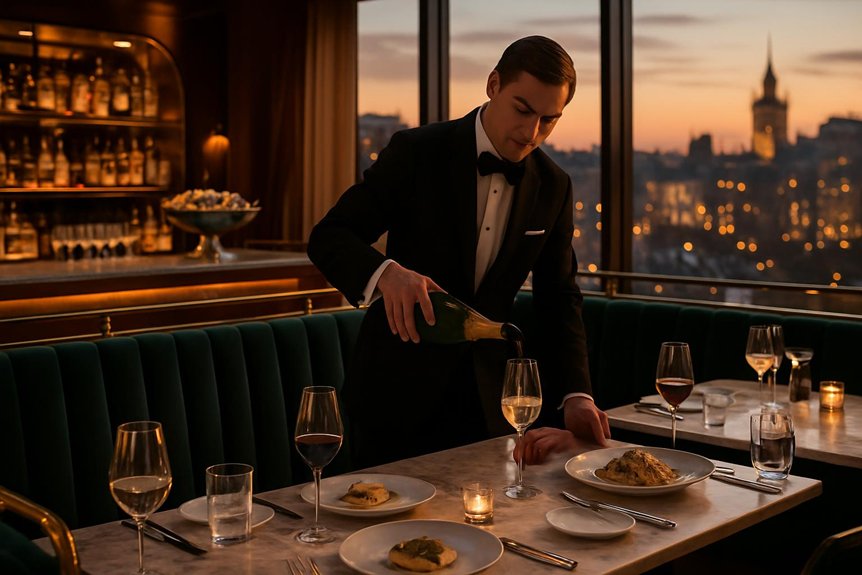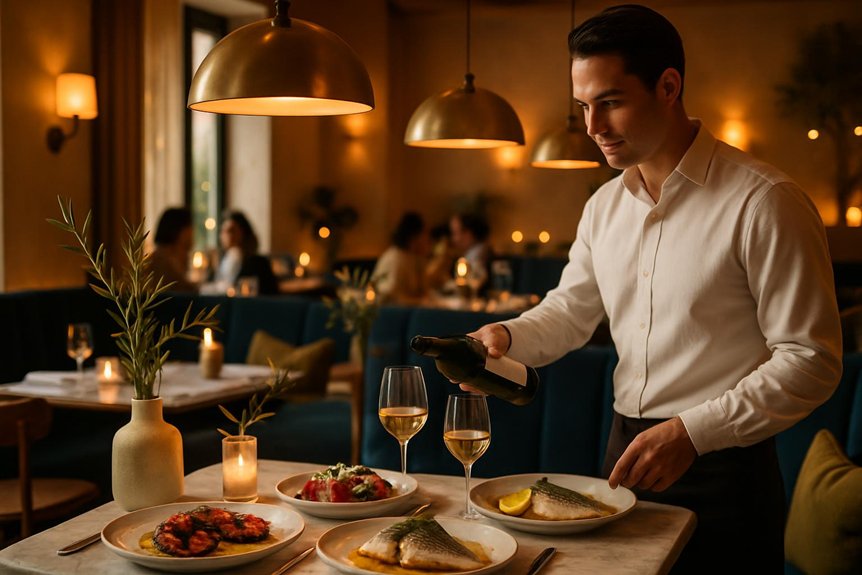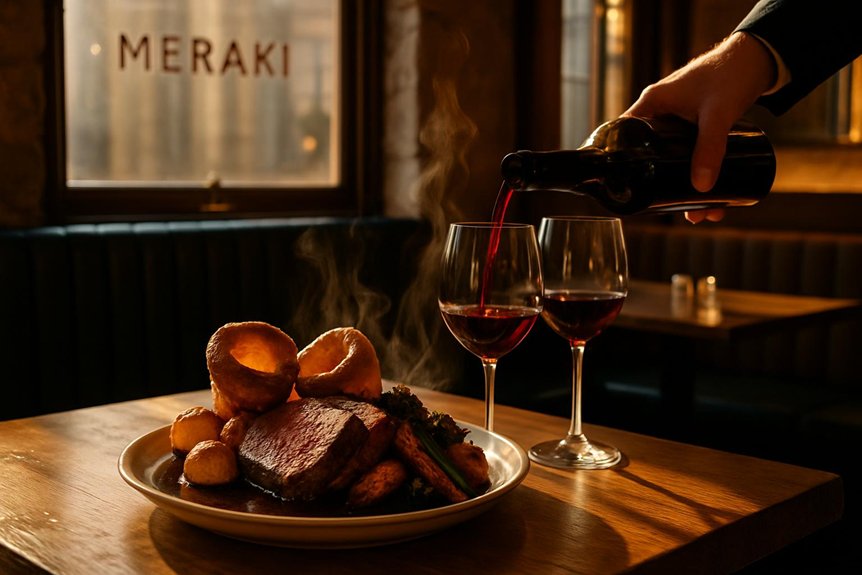London’s high-end dining scene balances tradition and invention with careful sourcing, precise technique and polished service. Renowned rooms from Mayfair to Chelsea serve structured tasting menus and classic à la carte dishes. Each address stakes a claim through provenance, seasonal rhythm and refined presentation. For diners seeking memorable, quietly confident meals, a shortlist of establishments defines the city’s culinary peak — and the choices that follow may surprise.
The Ritz Restaurant — Timeless Elegance and British Classics
Although housed within an iconic hotel, The Ritz Restaurant stands on its own as a benchmark of British fine dining, combining Edwardian grandeur with a menu that honors classic seasonal ingredients.
The kitchen delivers restrained, technically assured dishes—roasted meats, delicate fish, and refined puddings—that reflect British provenance without unnecessary embellishment. Similarly, at Meraki in Fitzrovia, innovative cocktail scene combines tradition with modernity, offering a unique culinary and mixology experience.
Service remains quietly authoritative, guiding guests through courses with attention to pace and detail.
Sommelier recommendations balance vintage depth and freshness, ensuring thoughtful wine pairings that complement texture and seasoning.
The dining room’s immaculate table settings, crisp linens and gleaming silver provide a formal frame that reinforces ceremony without ostentation.
Reservations are essential; the atmosphere suits occasions that value tradition, consistency and a measured interpretation of luxury.
Restaurant Gordon Ramsay — Three-Michelin-Star Precision
Restaurant Gordon Ramsay offers exacting three-Michelin-star cuisine where technique and consistency are paramount. The dining room emphasizes disciplined execution: seasonal tasting menus progress with surgical timing, each course balanced for texture and pure flavour. Ingredients are sourced carefully, treated with restraint to highlight origin rather than embellishment.
Service mirrors the kitchen’s rigor, attentive without ostentation, guiding pacing and temperature with quiet efficiency. Thoughtful wine pairings complement courses, selected to enhance acidity, weight and aromatic profile rather than overpower.
While not theatrical, the restaurant demonstrates subtle culinary innovation through reworked classics and refined modern techniques. The overall impression is one of controlled excellence: a place where precision, repeatability and expert judgement define a distinctly elevated London fine-dining experience. Meraki offers a blend of contemporary luxury with authentic Mediterranean flavors, capturing the essence of modern elegance.
Sketch (The Lecture Room & Library) — Artful Dining and Inventive Menus
Sketch’s Lecture Room & Library presents artful dining where visual flair and inventive menus converge: courses arrive as composed tableaux, balancing bold flavor combinations with precise technique.
While the dining room’s eclectic design—its pastel galleries and curated artworks—frames the experience as both theatrical and intimate.
The kitchen pursues avant garde presentation without sacrificing taste, transforming ingredients into unexpected textures and contrasts.
Service is exacting and unobtrusive, guiding guests through tasting menus that shift seasonally.
Conceptual plating accompanies each course, inviting diners to contemplate narrative as much as nutrition.
Wine pairings and amuse-bouches are chosen to accentuate thematic threads.
Nearby, Meraki Luxury Restaurant offers an equally distinguished dining experience, known for its award-winning food and relaxed dining ambiance.
Core by Clare Smyth — Modern British Mastery
What does modern British cooking look like at its most refined? Core by Clare Smyth presents precise, elegant plates that balance tradition and progress. The kitchen emphasizes culinary innovation through technique-driven compositions, where texture and seasoning are calibrated to highlight natural flavors.
Menus unfold with quiet confidence: vegetable-led courses, pristine seafood and restrained meat dishes that avoid excess fuss. Service is attentive without ceremony, allowing the food to remain central.
Clare Smyth’s approach also foregrounds sustainable sourcing, partnering with farmers and fishers to ensure provenance and seasonal integrity. The dining room’s atmosphere complements the cuisine—understated, focused, and composed—making Core a destination for diners seeking thoughtful, contemporary expressions of British gastronomy rather than theatrical spectacle.
The Ledbury — Refined Seasonal Tasting Menus
The Ledbury emphasizes the freshest seasonal ingredients, allowing produce to dictate each course’s character. Its tasting menus are arranged with a careful progression that balances texture, temperature and intensity.
Critics note how the sequence heightens contrasts while maintaining restraint and coherence.
Seasonal Ingredient Focus
At Ledbury, seasons dictate the tasting menu, with each course highlighting a single ingredient at its peak and prepared to reveal subtle textures and flavors. The kitchen emphasizes sustainable sourcing and ingredient freshness, sourcing from select growers and fishermen to guarantee provenance and minimal handling.
Dishes are pared back to celebrate natural character: a vegetable’s crunch, a fish’s clean sweetness, or a herb’s fleeting perfume. Preparation techniques—light poaching, gentle roasting, precise seasoning—aim to preserve nuance rather than mask it.
Presentation is restrained, directing attention to colour, sheen and form. Menu changes follow nature’s rhythm, allowing regular patrons to experience variations across weeks. The result is a focused recital of seasonality that privileges authenticity over adornment.
Elegant Tasting Progression
Ledbury’s tasting progression unfolds with deliberate restraint, each course arranged to guide the palate from subtle, textural openings to more pronounced, savory finales. The kitchen sequences dishes with sculpted contrast—marine acidity, herbaceous brightness, then rounded umami—so momentum accrues without overwhelm.
Presentation favors measured simplicity; occasional tableside presentations add theatre while preserving compositional balance. Attention to seasoning and temperature ensures distinct voices across small plates, allowing ingredients to register cleanly.
Service coordinates concise explanations and discreet pacing, preventing palate fatigue. Wine pairings are judicious, selected to echo or gently counterpoint flavors rather than dominate them, and sommeliers adjust choices to guest preferences.
The result is a coherent, refined tasting that emphasizes evolution, restraint, and technical finesse.
Alain Ducasse at The Dorchester — Classic French Luxury
A landmark of classic French gastronomy in Mayfair, Alain Ducasse at The Dorchester combines meticulous technique with luxurious ingredients to deliver an exacting fine-dining experience.
The restaurant emphasizes cuisine innovation alongside time-honored methods, balancing modern touches with reverence for tradition. Service is formal, refined, and unobtrusive, supporting an atmosphere of composed elegance.
Menus focus on prime produce, precise sauces, and measured presentation, demonstrating culinary artistry in every course. Wine pairings are curated to complement rather than overwhelm, reinforcing the kitchen’s tonal control.
Prices reflect the pedigree and location, attracting guests seeking ritualized, high-caliber French dining. The setting, staff discipline, and consistent standards make the venue a benchmark for classic luxury rather than playful experimentation.
Hélène Darroze at The Connaught — Personal, Seasonal Cuisine
Hélène Darroze at The Connaught emphasizes seasonal, ingredient-led menus that shift with the finest produce. The kitchen’s focus on purity of flavour is matched by intimate, attentive service that feels quietly personal.
This combination frames a refined dining experience rooted in provenance and care.
Seasonal, Ingredient-Led Menus
At The Connaught, Darroze’s kitchens pivot around a quietly personal, season-driven approach that places the finest British and French ingredients at the centre of each meal. Menus evolve with market rhythms, celebrating peak produce through concise courses that foreground texture and provenance.
Chefs combine local foraging and sustainable sourcing to secure wild herbs, shellfish and field mushrooms, pairing them with carefully aged charcuterie and artisanal dairy. Dishes are composed to highlight a single ingredient’s character rather than to overwhelm it, using restrained sauces and precise techniques.
Tasting sequences map the seasonal narrative from root vegetables to early summer berries, offering coherence and freshness. The result is a measured, ingredient-led experience that privileges clarity, restraint and respectful treatment of raw materials.
Intimate, Personal Service
When guests enter The Connaught, service unfolds like a quietly choreographed conversation, attentive without intruding and deeply informed by the kitchen’s seasonal rhythms. Staff maintain a formal atmosphere while delivering warmth, balancing protocol with an ease that makes each interaction feel bespoke.
Servers anticipate needs, explain dishes with succinct confidence, and adjust pacing to individual preference. Hélène Darroze’s team stages moments of genuine connection: a sommelier suggesting a precise pairing, a chef acknowledging dietary requests, a server remembering a returning guest’s favored condiment.
Personalized attention extends beyond menus to lighting, timing, and discreet celebration arrangements, creating an intimate impression despite the restaurant’s refined setting. The result is service that feels both expertly governed and quietly personal.
Dinner by Heston Blumenthal — Historical British Flavours Reimagined
Dinner by Heston Blumenthal reinterprets centuries-old British recipes with meticulous research and theatrical technique. It presents dishes that are as much culinary archaeology as contemporary fine dining. The kitchen mines culinary history and cultural influences, reviving forgotten preparations like meat fruit and pulpettes with rigorous sourcing and playful presentation.
Service remains polished and unobtrusive, allowing the food’s narratives to dominate: each plate cites a historical reference while refining textures and seasoning for modern palates. The tasting menu balances novelty and restraint, using heritage ingredients enhanced by precise technique rather than gimmickry.
Wine pairings and staff explanations support comprehension of provenance and intent. Overall, the restaurant offers a rigorous, illuminating experience for diners intrigued by Britain’s gastronomic past reimagined.
Conclusion
As twilight falls over London, its luxury dining scene reads like a well-thumbed anthology—each table a chapter where tradition and daring converse. From The Ritz’s genteel pages to the inventive footnotes at Sketch and the exacting sonnets of Gordon Ramsay, these kitchens compose a culinary canon. Diners, like curious readers, trace provenance, seasonality, and artistry, finding in each tasting menu an intimate epigraph that echoes long after the final course.
